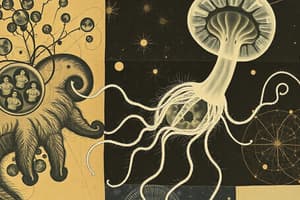Podcast
Questions and Answers
What process describes how Amoeba sp. captures food particles using its pseudopodia?
What process describes how Amoeba sp. captures food particles using its pseudopodia?
- Simple diffusion
- Binary fission
- Osmoregulation
- Phagocytosis (correct)
Amoeba sp. uses its cilia to move and capture food.
Amoeba sp. uses its cilia to move and capture food.
False (B)
What is the name given to the asexual reproduction method employed by Amoeba sp. under favorable conditions?
What is the name given to the asexual reproduction method employed by Amoeba sp. under favorable conditions?
Binary fission
In Paramecium sp., undigested food is expelled through the ______.
In Paramecium sp., undigested food is expelled through the ______.
Match the following processes with the corresponding organism:
Match the following processes with the corresponding organism:
Which of the following describes osmoregulation in Amoeba sp.?
Which of the following describes osmoregulation in Amoeba sp.?
Paramecium sp. reproduces sexually via binary fission when environmental conditions are unfavorable.
Paramecium sp. reproduces sexually via binary fission when environmental conditions are unfavorable.
What role do lysosomes play within the food vacuoles of unicellular organisms like Amoeba sp. and Paramecium sp.?
What role do lysosomes play within the food vacuoles of unicellular organisms like Amoeba sp. and Paramecium sp.?
Exchange of oxygen and carbon dioxide in both Amoeba sp. and Paramecium sp. occurs through ______ on the surface of the cell.
Exchange of oxygen and carbon dioxide in both Amoeba sp. and Paramecium sp. occurs through ______ on the surface of the cell.
Match each organism to its method of responding to adverse environmental conditions:
Match each organism to its method of responding to adverse environmental conditions:
Which structural feature is unique to Paramecium sp. and aids in directing food particles into its oral groove?
Which structural feature is unique to Paramecium sp. and aids in directing food particles into its oral groove?
Both Amoeba sp. and Paramecium sp. synthesize cytoplasm as a means of waste removal.
Both Amoeba sp. and Paramecium sp. synthesize cytoplasm as a means of waste removal.
Explain how the contractile vacuole in Amoeba sp. contributes to its survival in a freshwater environment.
Explain how the contractile vacuole in Amoeba sp. contributes to its survival in a freshwater environment.
Amoeba sp. extends its ______ to move and engulf food.
Amoeba sp. extends its ______ to move and engulf food.
Match each waste product with its primary method of removal in unicellular organisms:
Match each waste product with its primary method of removal in unicellular organisms:
How do Amoeba sp. respond to adverse stimuli such as bright light or certain chemicals?
How do Amoeba sp. respond to adverse stimuli such as bright light or certain chemicals?
The process of osmoregulation involves the absorption of nutrients through the cell membrane.
The process of osmoregulation involves the absorption of nutrients through the cell membrane.
How does the habitat of Amoeba sp. influence its need for osmoregulation?
How does the habitat of Amoeba sp. influence its need for osmoregulation?
In Paramecium sp., the rhythmic beating of ______ helps to move the organism.
In Paramecium sp., the rhythmic beating of ______ helps to move the organism.
Match the following structures with their functions in Amoeba sp.:
Match the following structures with their functions in Amoeba sp.:
Flashcards
Amoeba sp. movement
Amoeba sp. movement
Amoeba sp. moves by extending its pseudopodium and flowing cytoplasm into it.
Amoeba sp. response
Amoeba sp. response
Amoeba respond by moving away from things like chemicals or bright light.
Phagocytosis in Amoeba
Phagocytosis in Amoeba
The process where Amoeba sp. uses pseudopodia to trap food.
Nutrient absorption in Amoeba
Nutrient absorption in Amoeba
Signup and view all the flashcards
Waste discharge in Amoeba
Waste discharge in Amoeba
Signup and view all the flashcards
Gas exchange in Amoeba
Gas exchange in Amoeba
Signup and view all the flashcards
Osmoregulation
Osmoregulation
Signup and view all the flashcards
Binary fission in Amoeba
Binary fission in Amoeba
Signup and view all the flashcards
Spore formation of Amoeba
Spore formation of Amoeba
Signup and view all the flashcards
Paramecium movement
Paramecium movement
Signup and view all the flashcards
How Paramecium respond to stimuli
How Paramecium respond to stimuli
Signup and view all the flashcards
Exchange of gases
Exchange of gases
Signup and view all the flashcards
Paramecium waste removal
Paramecium waste removal
Signup and view all the flashcards
Paramecium reproduction
Paramecium reproduction
Signup and view all the flashcards
Study Notes
- Unicellular organisms consist of only one cell.
Amoeba sp.
- Constantly changes shape when encountering obstacles.
- Moves by extending a pseudopodium (false feet), followed by cytoplasm flow into it.
- Responds to stimuli (chemicals, touch, bright light) by moving away.
- Moves towards food, trapping particles via phagocytosis using its pseudopodium.
- Food vacuoles merge with lysosomes.
- Food particles are broken down by the enzyme lysozyme, which is located in lysosomes.
- Nutrients are then absorbed into the cytoplasm.
- Undigested food is discharged as it moves.
- Oxygen and carbon dioxide exchange occurs by simple diffusion through the plasma membrane.
- Growth occurs by synthesizing new cytoplasm.
- Waste products like carbon dioxide and ammonia are removed through diffusion.
- It lives in freshwater, water diffuses in by osmosis, filling the contractile vacuole.
- The contractile vacuole contracts and expels water at intervals (osmoregulation).
- Under suitable conditions with ample food, it reproduces asexually via binary fission through mitosis.
- In unfavorable conditions (dryness, low temperature, food shortage), it forms spores that germinate when conditions improve.
Paramecium sp.
- Moves using rhythmic cilia beats.
- Responds to stimuli by moving away.
- Cilia movement aids food particle transfer into the oral groove.
- Food vacuoles combine with lysosomes.
- Food particles are hydrolyzed by lysozyme enzymes.
- Nutrients get absorbed into the cytoplasm.
- Undigested food discharges through the anus.
- Gas exchange (O2 and CO2) occurs by simple diffusion across the plasma membrane.
- Growth arises from synthesizing new cytoplasm.
- Waste is removed by diffusion.
- In freshwater, water diffuses in, filling the contractile vacuole.
- Vacuole expansion leads to contraction and water excretion (osmoregulation).
- It reproduces asexually by binary fission during favorable conditions.
- Under unfavorable conditions, it undergoes sexual reproduction (conjugation).
Studying That Suits You
Use AI to generate personalized quizzes and flashcards to suit your learning preferences.




